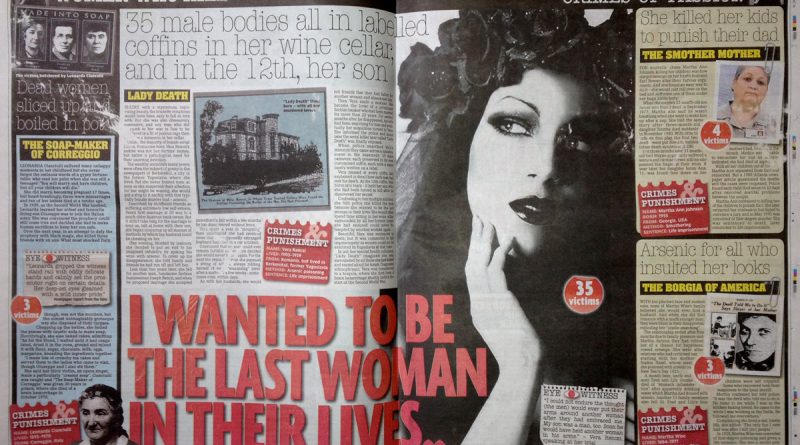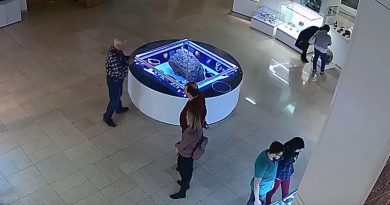Vera Renczi – The Black Widow Serial Killer Who Killed All Of Her Lovers
Born into a wealthy family with Hungarian origins from Bucharest, Romania, the family relocated to the town of Berkerekul (former Yugoslavia) when Renczi was ten. By the age of fifteen, she had become increasingly unmanageable by her parents and had frequently run away from home with numerous boyfriends, many of whom were significantly older than herself. Early childhood friends described Renczi as having an almost pathological desire for constant male companionship and possessing a highly jealous and suspicious nature. Although Vera Renczi was a stunningly beautiful woman (according to the standards of the time, I guess), she was also one of the most prolific female serial killers in history, driven by a pathological need for devotion from men.
Renczi’s first marriage was to a wealthy Bucharest businessman many years her senior and she bore him a son named Lorenzo. Left at home daily while her older husband worked, she began to suspect that her husband was being unfaithful. One evening, in a jealous rage, Renczi tinctured the man’s dinner wine with arsenic and began to tell family, friends, and neighbors that he had abandoned her and their son. After approximately a year of “mourning”, she then declared that she had heard word of her supposedly estranged husband’s death in a car accident
Shortly after hearing the news of her first husband’s “automobile accident” Renczi again remarried, this time to a man nearer her own age. However, the relationship was a tumultuous one and Renczi was again plagued by the suspicion that her new husband was involved in extramarital affairs. After only months of marriage the man vanished and Renczi then told friends and family that the man had abandoned her. After a year had passed, she then claimed to have received a letter from her husband proclaiming his intentions of leaving her forever. This would be her last marriage.
Although Vera-Renczi would not remarry, she would spend the next several years carrying out a number of affairs, some clandestine with married men, and others openly. The men came from an array of backgrounds and social positions. All would vanish within months, weeks, and in some cases, even days after becoming romantically involved with her. When connected to men she was openly having an affair with, she would invariably concoct stories of them being “unfaithful” and having “abandoned her”.
After the wife of one of Renczi’s lovers followed him to Renczi’s residence one evening and the man subsequently never returned home, the police were called to investigate his disappearance. Upon searching Renczi’s wine cellar, they discovered 32 unburied, zinc-lined coffins. Each contained a male corpse in varying stages of decomposition.Renczi was arrested and taken into police custody where she confessed to having poisoned the 32 men with arsenic when she suspected they had been unfaithful to her or when she believed their interest in her was waning. She also confessed to the police that on occasion she liked to sit in her armchair amidst the coffins, surrounded by all of her former suitors.
Vera-Renczi also confessed to murdering her two husbands and her son Lorenzo. She told police that one day when her son had come to pay her a visit, he had accidentally discovered the coffins in her wine cellar and threatened to blackmail her and she subsequently poisoned him and disposed of his body. She also feared he would soon leave her to marry someone so she held him in her arms as he lay dying so she would be the last person to hug him.
She was convicted of 35 murders and sentenced to life imprisonment, where she subsequently died. Some have speculated that Renczi’ story may have inspired Joseph Kesselring’s play Arsenic and Old Lace, yet this is incorrect. It was the Amy Archer-Gilligan case which the playwright used as his model.
Vera Renczi is known as the biggest romanian serial killer and a mistery for criminalists. Her real name is not known apparently Renczi is her second husbands name. Some sources claim that she was born in 1903 in Bucharest, being the doughter of a romanian beautiful woman and a hungarian businessman. When she was 13, her mother dies and Vera moves with her father in Berkerekul, a town in former Yugoslavia. In her adolescence was involved in many sexual scandals, until she meets her first husband: Karl Schick, an Austrian banker. After a year, Lorenzo their son is born and Karl disappears. She explains to her friends that Karl left them and he died in a car accident in Romania. After a while she marries Joseph Renczi, a very influent businessman. A short time after their marriage, Joseph disappears too.
She was always dressed in black and had a lot of lovers that disappeared after visiting her. When the wife of one of her lovers insisted to search her place, the police discovered 35 zinc coffins with her lovers. The police also discovered in one of the coffins the body of Lorenzo her 10 year old son she had to kill because he discovered her terrible secret.
She killed all her victims poisoning them with arsenic.Because the law did not allow to execute women she was transferred to a maximum security prison where she died shortly afterwards due to a cerebral hemorrhage.
Vera Renczi Used Men as Disposable Sex Objects –
An extraordinary case, reported from Kerekul, in Jugo-Slavia, is being widely discussed in Paris, and has given rise to the argument that woman is more cruel in man. A handsome young woman of wealth there is accused of murdering thirty-five husbands and lovers, simply because she could not bear to think they might love another woman.
As far as modern conditions permit, Madame Vera Renczi, of Berkereckul, is the reincarnation of merciless Queen Margaret of Burgundy, sitting in her fascinating Tour de Nesle and seeking for beautiful youths to destroy.
The complaint of a young married woman of the town that her husband, a leading banker, had disappeared after visiting Madame Renczi was the final stop that led the investigation of her career. Rumors of strangely missing men had been current for some time, but many persons feared to take action against the rich and distinguished widow, who seemed to exert a mysterious fascination over all who came contact with her. Nearly all the missing men were from distant places, and there was no relation at hand to investigate their disappearance.
At last, came the pointed demand from bankers wile that the police should search the cellar of Madame Renczis home, an ancient chateau.
Realizing that the reputation of the town was at stake, the police acted with great energy. Before Madame Renczi had no idea of the charges against her they surrounded her chateau and broke into the cellar. To get there they had to go through long vaulted stone corridors and break through three iron doors. An old woman servant resisted their entry fiercely, and they were obliged to handcuff her. When at last they reached the vast, vaulted cellar an astounding sight revealed itself beneath the light of their electric torches. Neatly arranged around the cellar were no less than thirty-five zinc coffins, each of them bearing the name and age of the occupant. All the occupants were males.
The police immediately arrested Madame Renczi, who had been trapped in her luxurious boudoir. She was taken before an examining magistrate on charges of causing the death of Leo Pachich, the banker, and other persons.Careful investigation showed that the coffins in the cellar bore the names of two of her husbands, of her young son [aged 10], and thirty-two men who had been her lovers.At first she boldly denied her guilt and protested with indignation at her arrest.You have brought disgrace upon our town and I will have you all severely punished, exclaimed the imperious beautywith flaming eyes.
Why did you have thirty-five bodies in your cellar? she was asked.
They are friends and relations whom I have cared for. Some of them were townspeople who were killed by the Germans when they passed through this place.
The police went to work, patiently investigate every act of her life for years past, and soon found overwhelming evidence of her guilt. Every man whose name appeared on her coffins was traced to her house. From that moment his appearance in the outside world ceased.
In a secret compartment behind the wall of her boudoir was found enough arsenic to kill a hundred men. This poison is very common in Jugo-Slavia, being found in combination with metals in several mines there.
Madame Renczi had apparently used this poison on nearly all her victims. She gave it to them in the choice wines with which she lured them to their destruction. She fed it to them in the dishes of the delightful dinners she served them.
Arsenic, as most people know, can be given in carefully measured quantities so as to cause death as slowly as may be desired. Given in this way, it does not immediately produce sickness, but makes its victims feel unusually well.
It was a strange end her victims met. Lured on by a beautiful and fascinating woman, entertained with banquets and wines insidiously poisoned, they were like men bewitched. Sometimes, apparently, they knew that death was coming upon them, but, like the knights in the Venusberg, they were powerless to flee.
In face of the overwhelming proof, Madame Renczi at last broke down and confessed her crimes. The police magistrate, a hardened official, was nearly overcome as he went through the terrible list of crimes with which this young woman had afflicted the world almost since childhood.
Why did you kill all these human beings? he asked.
They were men, she answered. I could not endure the thought that they would ever put their arms around another woman after they had embraced me.
It was shown that the woman was possessed by the passion of jealousy to a degree never before recorded.
But, the judge stammered, you also murdered your own son.
He had threatened to betray me, said Madame Renczi. He was a man, too. Soon he would have held another woman in his arms.
The police immediately arrested Madame Renczi, who had been trapped in her luxurious boudoir. She was taken before an examining magistrate on charges of causing the death of Leo Pachich, the banker, and other persons.
Careful investigation showed that the coffins in the cellar bore the names of two of her husbands, of her young son [aged 10], and thirty-two men who had been her lovers.
At first she boldly denied her guilt and protested with indignation at her arrest.
“You have brought disgrace upon our town and I will have you all severely punished,” exclaimed the imperious beauty—with flaming eyes.
“Why did you have thirty-five bodies in your cellar?” she was asked.
“They are friends and relations whom I have cared for. Some of them were townspeople who were killed by the Germans when they passed through this place.”
The police went to work, patiently investigate every act of her life for years past, and soon found overwhelming evidence of her guilt. Every man whose name appeared on her coffins was traced to her house. From that moment his appearance in the outside world ceased.
In a secret compartment behind the wall of her boudoir was found enough arsenic to kill a hundred men. This poison is very common in Jugo-Slavia, being found in combination with metals in several mines there.
Madame Renczi had apparently used this poison on nearly all her victims. She gave it to them in the choice wines with which she lured them to their destruction. She fed it to them in the dishes of the delightful dinners she served them.
Arsenic, as most people know, can be given in carefully measured quantities so as to cause death as slowly as may be desired. Given in this way, it does not immediately produce sickness, but makes its victims feel unusually well.
It was a strange end her victims met. Lured on by a beautiful and fascinating woman, entertained with banquets and wines insidiously poisoned, they were like men bewitched. Sometimes, apparently, they knew that death was coming upon them, but, like the knights in the Venusberg, they were powerless to flee.
In face of the overwhelming proof, Madame Renczi at last broke down and confessed her crimes. The police magistrate, a hardened official, was nearly overcome as he went through the terrible list of crimes with which this young woman had afflicted the world almost since childhood.
“Why did you kill all these human beings?” he asked.
“They were men,” she answered. “I could not endure the thought that they would ever put their arms around another woman after they had embraced me.”
It was shown that the woman was possessed by the passion of jealousy to a degree never before recorded.
“But,” the judge stammered, “you also murdered your own son.”
“He had threatened to betray me,” said Madame Renczi. “He was a man, too. Soon he would have held another woman in his arms.”



